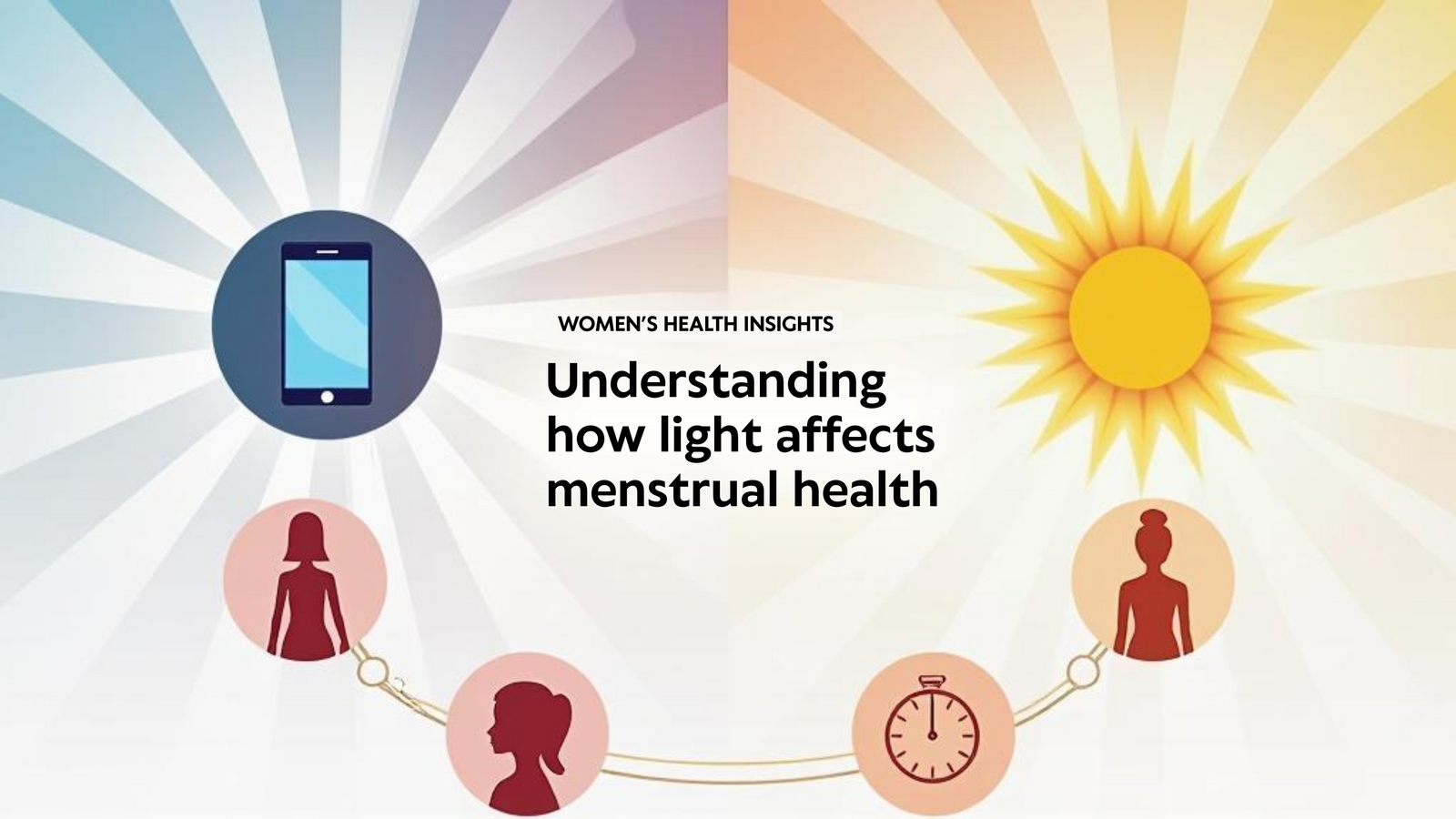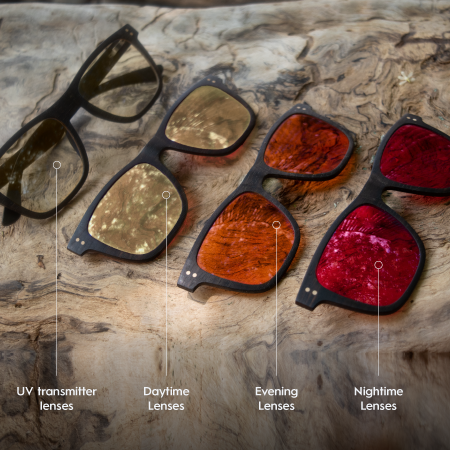The Hidden Connection Destroying Women's Health: Your Monthly Cycle & Light

The problem every woman recognizes
"I have irregular periods." "My cycle is all over the place." "I can't sleep since perimenopause started."
Here's what I hope every woman will understand from this article: You are not broken! You don't have a hormone problem. You don't have a menstrual problem. You don't have a menopause problem.
Those are the symptoms of a hidden root cause…
You are not the cause. Your environment is
It's not about you. You have a LIGHT problem.
The Hidden Truth About Your Two Biological Clocks
Most people think that light and circadian rhythm are just about sleep.
It doesn't end there.
Your circadian clock orchestrates the timing of when your body releases different hormones.
✅ When your body secretes the right hormones at the right time, life flows effortlessly
❌ On the flip side, if the body is receiving the wrong light information at the wrong time of the day, it disrupts your hormonal production and life becomes a bitter roller coaster.
As women, you have two biological clocks running your body:
- The 24-hour circadian clock (your daily rhythm)
- The 28-day infradian clock (your menstrual cycle)
Here's where it gets fascinating…
These clocks don't run independently. They're like gears in a sophisticated biological machine: when one breaks, the other can't function properly either.
In short, the quality of your menstruation cycle is deeply connected to the quality of light entering your eyes
The Massive Study That Proves It
And here's the proof: A 2023 meta-analysis pulled data from 21 separate cohorts—nearly 200,000 women—to examine the effects of circadian disruption.
The conclusion was striking:
- ~30% higher odds of irregular periods
- More painful cycles (dysmenorrhea)
- A higher risk of earlier menopause 【Hu 2023】
This wasn't just one small trial—it was decades of research confirming that circadian disruption consistently destabilizes women's cycles and accelerates reproductive aging.
Why? Because when your daily gear is broken, your monthly gear can't run smoothly.
Additional 2025 research findings
Another 2025 study using female mice exposed to rotating light schedules (mimicking circadian disruption) revealed:
- 50% developed irregular cycles with hormonal imbalances
- All mice (including those with seemingly normal cycles) showed internal reproductive system desynchronization
Another solid proof showing that when your daily gear is broken, your monthly cycle can't function properly
How Your Morning Hormone Factory Actually Works
When you first wake up and natural light enters your eyes, your body converts some of the pregnenolone—the "mother hormone"—into cortisol. This healthy morning surge makes you feel alert, focused, and energized.
Under balanced conditions, the rest of that precious pregnenolone flows into youth and sex hormones like estrogen and progesterone. These hormones keep your energy up, stabilize your cycle, and maintain your youthful skin and hair.
How Artificial Light Is Sabotaging Your Cycles
When Lights Become Tigers
Now here's what's absolutely fascinating about your biology:
If your mitochondria, those cellular Ferrari engines, sense a threat in the environment, like a tiger chasing you, the pregnenolone gets diverted from fertility and youth pathways to produce MORE stress hormones like cortisol so that you can fight or flee and survive.
And here's the shocking truth:
It turns out that modern artificial lighting is perceived as a THREAT by your mitochondria!
The Scientific Proof That Light Controls Your Fertility
Fritz Hollwich's Fertility Warning
A German scientist called Fritz Hollwich published groundbreaking studies showing that sitting under artificial blue light increased the stress hormones cortisol and ACTH abnormally.
As a result, your mitochondria divert pregnenolone from sex hormone pathways to produce MORE cortisol. This really taxes your sexual glands and leads to brain fog and sluggishness.
Artificial Light and Hormone Production
Metabolic Protection Loss
During your reproductive years, estrogen and progesterone aren't just managing fertility. They're acting as powerful metabolic bodyguards:
- Protecting you from obesity by improving insulin sensitivity
- Reducing your risk of type 2 diabetes
- Shielding your liver from fat accumulation
This is why women typically have lower rates of metabolic disease than men: until menopause hits.
But here's the alarming part: When your circadian rhythm is disrupted by artificial light, you start losing this protection YEARS before menopause even begins.
This raises a critical question
Are you deemed to lose this protection against chronic disease as you approach menopause?
Menopause, Sleep, and Light Disruption
The Menopause Transition and Light Exposure
The short answer is a definite NO
Nature has designed a smooth, natural and graceful transition that is the birthright of every menopausal woman.
Here is how…
During pre-menopause, your ovaries slowly stop producing sex hormones. But in a healthy woman, the adrenal glands are supposed to compensate by secreting small quantities of estrogen and progesterone to ensure the transition goes smoothly and is as easy as possible.
But here is the problem that every woman living in the modern world is suffering from
Chronic stressors like artificial blue light impede this natural transition by forcing the conversion of pregnenolone to cortisol instead of youth hormones.
Result: The hormone support system breaks down, leading to severe menopausal symptoms including hot flashes, weight gain, and fatigue.
Early Menopause Is Linked to Light
The negative impact doesn't stop there
As it turns out, the circadian disruption doesn't just make periods irregular—it may shorten the entire reproductive lifespan.
Here is how research proved this: One of the world's largest women's health studies followed more than 80,000 nurses over two decades. Researchers found that women who had recently experienced chronic circadian disruption were more likely to enter menopause earlier, especially those under age 45.
The more years of disrupted rhythms, the stronger the effect.
Your Women's Light Optimization Protocol
1. Morning Power Ritual
Get 15–30 minutes of natural sunlight exposure within the first hour of waking (no sunglasses). This anchors both your daily AND monthly rhythms while supporting healthy cortisol and pregnenolone production.
2. Cycle Syncing
During your luteal phase (days 15–28), be extra protective of evening darkness—your progesterone production depends on it. This is when your body needs the deepest darkness to support hormone synthesis.
3. Midlife Reset
If you're in perimenopause or menopause, embrace your natural phase advance. Go to bed earlier. Wake earlier. Work WITH your shifting biology, not against it. Support your adrenals as they take over hormone production.
4. Evening Sanctuary
Dim your lights after sunset. Use warm, low lighting under 3000K. Create the darkness your hormone factory is craving to produce youth hormones instead of stress hormones.
This is also where circadian glasses like VivaRays® 3-in-1 Light Optimization Glasses become powerful. They're designed to filter harmful blue and green light at the right times of day, supporting your natural hormone production without forcing you to live in total darkness after sunset.
5. Stress Shield
Combine light optimization with stress management. Find habits that work for you like listening to Theta waves music or practicing deep and slow breathing.
The Truth That Will Set You Free
You Are Not Broken. Your Light Environment Is.
Whether you're struggling with irregular cycles, fertility challenges, or midlife sleep disruption—the solution isn't more pills, supplements, or hormone replacement.
It's about working WITH your natural biological design instead of fighting against it.
Your ancestors' hormones cycled in perfect harmony with natural light patterns for millions of years. That ancient wisdom is still encoded in your DNA.
Step into the light during the day. Embrace darkness at night.
Your cycles will thank you. Your fertility will thank you. Your midlife transition will thank you.
The light movement starts with you, and it starts now.
Frequently Asked Questions
📚 References
Hu, F., et al. (2023). Shift work and menstruation: A meta-analysis study. SSM – Population Health, 24, 101542.
👉 Read on ScienceDirect
Garmier-Billard, M., et al. (2020). Nocturnal light pollution and clinical signs of ovulation disorders. Trends in Medicine (OAText), 20, 1000193.
👉 Full Text (OAText)
Gooley, J. J., et al. (2011). Exposure to room light before bedtime suppresses melatonin onset and shortens melatonin duration in humans. Journal of Clinical Endocrinology & Metabolism, 96(3), E463–E472.
👉 Read on Oxford Academic
Zeitzer, J. M., et al. (2000). Sensitivity of the human circadian pacemaker to nocturnal light: melatonin phase resetting and suppression. Journal of Physiology, 526(3), 695–702.
👉 Read on Wiley Online Library
Yaw, A., et al. (2025). Shiftwork-like light exposure and female reproductive health. ENDO 2025 – Endocrine Society Meeting (press release).
👉 ENDO Press Release
Sen, A., & Sellix, M. T. (2016). The circadian timing system and environmental circadian disruption: From follicles to fertility. Endocrinology, 157(9), 3366–3373.
👉 Read on Oxford Academic




Leave a comment